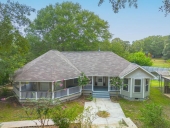posted 6 years ago
This thread raises a lot of really important issues, but this post will just address the cost of straw bale construction.
There’s a lot of confusion around the cost of building with straw bales, and that confusion has a lot of sources. One is that when owner-builders report what it “cost” them to build a straw bale house they rarely include their own labor in the price Yet in most construction—natural building and conventional—labor accounts for around 2/3rds of the cost of a building.
Today, if someone spends around $100K on building materials (foundation, framing, insulation, electrical, plumbing, roofing, siding, interior finishes, windows, doors, etc.), there’s a pretty good chance that hired labor would have cost another $200K. It has probably been this way for a very long time.
Case in point. I recently saw an inspiring article about a 99 year old man who built a straw bale home for his family in Douglas, Wyoming, back in 1948. He still lives in that home! The story didn’t get into details except that the walls were straw bale, it was initially a single large room, and that he mixed the concrete foundation by hand. I’ll bet that in 1948 he did pretty much everything else by hand, too, because many of the labor-saving power tools we take for granted today weren’t available then. Think cutting lumber with a hand saw and driving nails with a hammer. The owner-builder kept meticulous records, and spent just $2,500 for that straw bale home. Impressive, right?
If the material-to-labor ratio we see today was true nearly seventy-five years ago, then he would have paid around $7,500 for that home had he hired contractors to build it. In fact, the median price of a new home (built by contractors) in 1950 was $7,354. This story suggests powerfully that saving money comes not from the use of straw bales or any other particular materials—although some will cost less than others. The real savings flows from building it yourself.
Keep in mind that homes were quite small back then—the average home in 1950 was less than 1000 square feet, tiny compared to the average size today of around 2,500 square feet.
A well designed, well built, well cared-for straw bale home will perform as well-as or better than other building systems, last as long or longer, be healthier for the occupants, store more carbon, and be beautiful, too. Using more local materials helps local economies. I hope more people build with straw for all of these reasons. But unless they can contribute quite a bit of labor to the project, straw bale building isn’t necessarily less expensive than conventional alternatives.
Costs vary widely by region, whether building codes and permits are involved, and whether built in a rural or urban area. Many design features influence this cost. The building site, wall height, whether the building’s footprint is simple (rectangular) or complicated, the finish level for both interior and exterior walls, etc., all factor in. And that’s just for the plastered straw bale wall assembly!
Remember, straw bale buildings have much in common with other buildings. They all have roofs, floors, windows, doors, ceiling insulation, partition walls to create rooms, electrical, plumbing, and HVAC. Here in North America most straw bale buildings are post-and-beam—the straw bales are used for insulation and a lath for plaster—so most straw bale buildings also use lumber, too (there are a lot of reasons for this—the subject of another discussion). The article that Dave Burton references is absolutely correct—the plastered straw bale wall portion of a building’s cost is usually less than 25% of the building’s total cost.
What does all of that mean in terms of dollars? Here in rural S. Oregon a modest, entirely contractor-built straw-bale house built in 2019 will likely start around $200 per square foot—which is also the low-end of the scale for any “green” building in this area. Remember, up to 60 – 70% of this cost is labor—hiring contractors to do the work. My colleagues in more urban areas like Portland or the San Francisco Bay Area report that prices are much higher—starting out around $300 per square foot. Green buildings—whether made of straw or conventional materials—both cost around 20% - 30% more than conventional structures designed and built to satisfy minimum code requirements. But green buildings made with straw also store carbon, and if carefully designed and built, can be Net-Zero in terms of energy use, and make a larger climate-change difference sooner.
Whether something is “affordable” depends quite a bit on expectations. When people read somewhere that they can build a straw bale home for “$20 per square foot” or some other very attractive low price, it’s easy to form the impression that straw bale buildings can be built inexpensively. We need to view cost information more critically by asking a few questions. When was the article written; in the mid-1980s or last year? Did the cost figure include labor? Was it a code-level, permitted building? Was it a simple design (e.g. rectangle with a gable or shed roof)?
The take-away is that if you can build your own home (of straw bales or any other material) you can save a lot of money! But if you’re not able to contribute labor, and you want an “average” sized home by today’s standards, building with straw bales probably isn’t going to cost less than other comparable homes in your area.









 1
1




 2
2




 1
1


























 2
2




 1
1


















 1
1












 1
1











